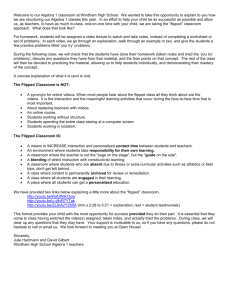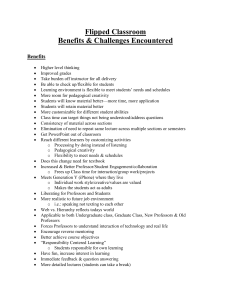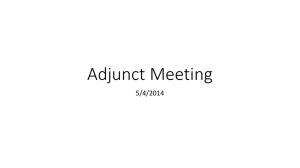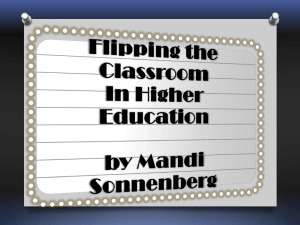The Flipped Classroom - lauraterrill - Presentations
advertisement
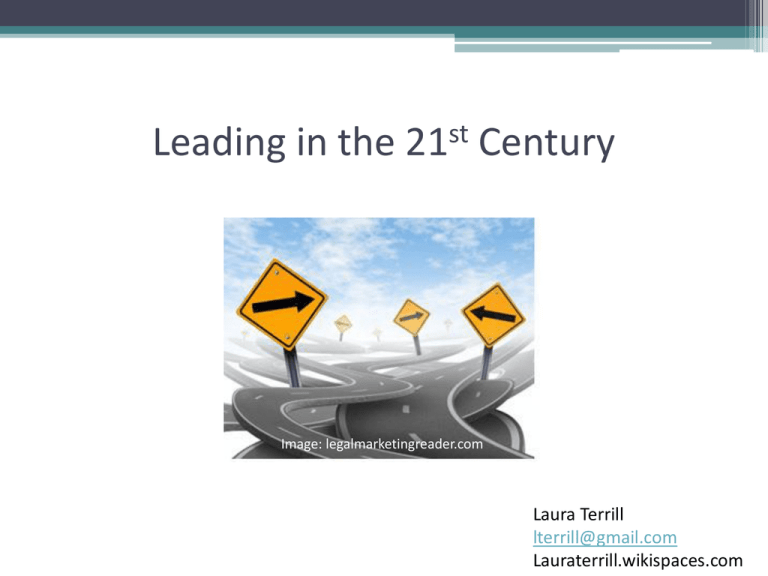
Leading in the 21st Century Image: legalmarketingreader.com Laura Terrill lterrill@gmail.com Lauraterrill.wikispaces.com Essential Question How can we leverage what we control to meet our goals? Agenda 1. Why change? 2. What about flipped classrooms? 3. What constitutes a viable and guaranteed curriculum? 4. How do I motivate others? 5. What about me? Daniel H. Pink: Why bosses need to show their soft side If you ever want to understand your boss, corner him (or her) at the next office party and see if he’ll play a little game. Tell him (or her) you need only 30 seconds. Then ask your boss to extend his (or her) right forefinger…….. http://www.telegraph.co.uk/journalists/daniel-h-pink/8641925/Daniel-H.-Pink-Why-bosses-need-to-show-their-soft-side.html Rachel Bolstad Image: http://www.shiftingthinking.org/?tag=educational-debate http://www.youtube.com/watch?v=pQHX-SjgQvQ Embrace Change People are more willing to embrace change when they: • Hurt enough that they are willing to change. • Learn enough that they want to change. • Receive enough that they are able to change. Thinking for a Change John C. Maxwell Ask Why Before How? Asking why helps you to think about all the reasons for decisions. It helps you to open your mind to possibilities and opportunities. Thinking for a Change John C. Maxwell Big-Picture Thinking You’ve got to think about ‘big things’ while you’re doing small things, so that all the small things go in the right direction. — Alvin Toffler http://www.youtube.com/watch?v=PCtwPYeTwI0&feature=related Switch — How to Change Things When Change is Hard Chip Heath and Dan Heath Direct the Rider image: californiahorseback.com image: tripadvisor.com • Identify the bright spots. Investigate what’s working and clone it. Knowledge alone does not change behavior. • Script the critical moves. Don’t think big picture, think in terms of specific moves. Ask “What is the first small sign you’d see that would make you think that change is happening?” • Point to the destination. Change is easier when you know where you are going and why it is worth it. Switch — How to Change Things When Change is Hard Chip Heath and Dan Heath Motivate the Elephant image: mirror-au-nsw1.gallery.hd.org • Find the feeling. Knowing something isn’t enough to cause change. Make people feel something. • Shrink the change. Connect the longterm goal with short-term critical moves. • Aim for small wins that are meaningful and within immediate reach. Early successes engineer hope. • Grow your people. Cultivate a sense of identity and instill the growth mindset. Switch — How to Change Things When Change is Hard Chip Heath and Dan Heath Shape the Path image: tripadvisor.com • Tweak the environment. When the situation changes the behavior changes. So change the situation. • Build habits. When behavior is habitual, it’s free—it doesn’t tax the Rider. Look for ways to encourage habits. • Rally the herd. Behavior is contagious. Help it spread. SUPERINTENDENT Image: http://www.ideachampions.com Administration has decreed that all teachers must incorporate 21st Century Skills into their lessons and has decided that evidence of flipped classrooms will be a key way to determine if these goals are being met. Global language students understand cultural issues. Learners use target language. Students engage. The Flipped Classroom: Pro and Con What It Is According to the description on ASCD(3)'s page for the newly released book, Flip Your Classroom: Reach Every Student in Every Class Every Day(4), by flipped classroom pioneers Aaron Sams and Jonathan Bergmann, "In this model of instruction, students watch recorded lectures for homework and complete their assignments, labs, and tests in class………. The authors go on to explain that the model is a mixture of direct instruction and constructivism, that it makes it easier for students who may have missed class to keep up because they can watch the videos at any time. The argument also goes …. Strategy: Read * Cover * Remember * Retell Students pair and read a predetermined amount of text silently. When they reach the designated stopping point, both students should cover the passage and think about what they remember. Then, one student keeps the passage covered and sumarizes the information for the other student. The second student looks at the passage to verify accuracy, asks questions to prompt for more detail or simply reads key information that was not in the summary. Source: www.edutopia.org/blog/flipped-classroom-pro-and-con-mary-beth-hertz What It Isn't As with any new fad or trend, there are plenty of people trying to either use the model to make money or jump on the bandwagon without really understanding what they are joining. For instance, the company TechSmith(9) has an entire part of their site dedicated to the flipped classroom model. Now, I happen to think that TechSmith makes great products and are pretty good at keeping a finger on the pulse of education. However, it's no secret why TechSmith, who creates screencasting software, would be interested in the flipped classroom approach(10). ……….If I were your average principal or tech director walking around the exhibit hall without much knowledge of the model, or a misconception of the model, I could really end up getting the wrong information. I have often seen and heard the Khan Academy(11) come up in discussions around the flipped classroom. ……..Good instruction, especially for math concepts, requires that ideas be presented in a number of ways. In addition, not all math is solving equations. One of the hardest parts about teaching math is making sure that students are not blindly solving equations without really understanding what they are doing with the numbers…….. Strategy: Say Something Students pair and read a predetermined amount of text silently. When they reach the designated stopping point, they each need to say something. They can make a prediction, ask a question, make a comment or make a connection. If one person can’t do one of the 4 choices, he/she needs to reread. The pair continues to read another section silently, alternating who begins to say something with each passage. Why It Works Most of the blog reflections I have read and the conversations I have followed point to the way that the flipped classroom has truly individualized learning for students. Teachers describe how students can now move at their own pace, how they can review what they need when they need to, and how the teacher is then freed up to work one-on-one with students on the content they most need support with..……. Why It Doesn't Work When I first started learning about the flipped classroom model, my immediate reaction was, "This won't work with my students." This continues to be an argument made by a lot of rural and urban teachers. Our students just don't have the access required for the model to really work. I've had people tell me, "They can use the public library.”…… Strategy: Connections Make a text-to-self connection. Explain how what you are reading connects to your life. Other possible connections are text-to-text or text-to-world. Why It's Nothing New Listening to Aaron Sams talk(14) about his experience with the flipped classroom model, one can't help but imagine that what he is describing doesn't require video at all. What he describes is, in essence, what John Dewey described at the turn of the 20th century: learning that is centered around the student, not the teacher; learning that allows students to show their mastery of content they way they prefer….. Why It Matters So in the end, why should we care so much about the flipped classroom model? The primary reason is because it is forcing teachers to reflect on their practice and rethink how they reach their kids. It is inspiring teachers to change the way they've always done things, and it is motivating them to bring technology into their classrooms through the use of video and virtual classrooms like Edmodo and similar tools. As long as learning remains the focus…… Strategy: Most Important Word/Sentence/Idea Select the 2 or 3 words that are most important to you and be able to explain why in the context of your current position. usergeneratededucation.wordpress.com Structured Debate Will flipped classrooms enhance student learning? Image: blog.tophatmonocle.com Administration has decreed that all teachers must incorporate 21st Century Skills into their lessons and has decided that evidence of flipped classrooms will be a key way to determine if these goals are being met. Roles in the debate: • a department chair/leader responsible for implementation • a teacher weary of the llast “new” thing • a good student easily bored in school • a student who struggles and rarely does homework Consider: • the potential for differentiation • student preferences/learning styles • the role/impact of homework on student learning • the potential impact of flipping on curriculum, instruction and assessment • challenges inherent in any “new” initiative How to Start Academic Conversations Jeff Zwiers and Marie Crawford Educational Leadership/April 2009 • I think the author wrote it to teach us about… • One theme might be…… • I think it means that…. • In other words…… • For example…. • In the text, it said that….. • One case showed that….. • I would add that…… • Then again, I think that…. Teach the Language of Discussion / Debate • I want to expand on your point about…. • In my life…. • I think it can teach us…. • If I were…., I would have… • We can say that….. • The main theme/point of the text seems to be…. How to Start Academic Conversations Jeff Zwiers and Marie Crawford Educational Leadership/April 2009 Scored Discussion Move from: Asks random questions Only answers the question asked Responds, but rarely initiates Comments are not relevant 1–3–5 Move to: Follows up with logical questions Contributes additional information Contributes personal insights to enhance discussion and draw in others Stays on topic Gretta Murray, French Teacher, Medford, WI Everything you know about curriculum may be wrong. Really. Question It (the text) says… I say… And so? If curriculum is a tour through what is known, how is knowledge ever advanced? If learning requires a didactic march through content, why are movies and stories so memorable – often, more memorable than classes we once took? If a primary goal of education is high-level performance in the world going forward, how can marching through old knowledge out of context optimally prepare us to perform? If education is about having core knowledge, and we are more and more teaching and testing all this knowledge, why are results on tests like NAEP so universally poor, showing that over decades American students have not progressed much beyond basic “plug and chug”? http://grantwiggins.wordpress.com/2012/03/13/everything-you-know-about-curriculum-may-be-wrong-really/ 1. 2. 3. 4. 5. Write one word or short phrase on up to 3 post it notes. Add your notes to the wall. Read the post it notes. Collaborate to group key ideas. Take a sheet of paper and write one question that you are considering. Laura Terrill World Language / ELL Consultant 8529 Stark Drive Indianapolis, IN 46216 Cell: 314-369-9678 Home: 317-546-2626 Email: lterrill@gmail.com lauraterrill.wikispaces.com

